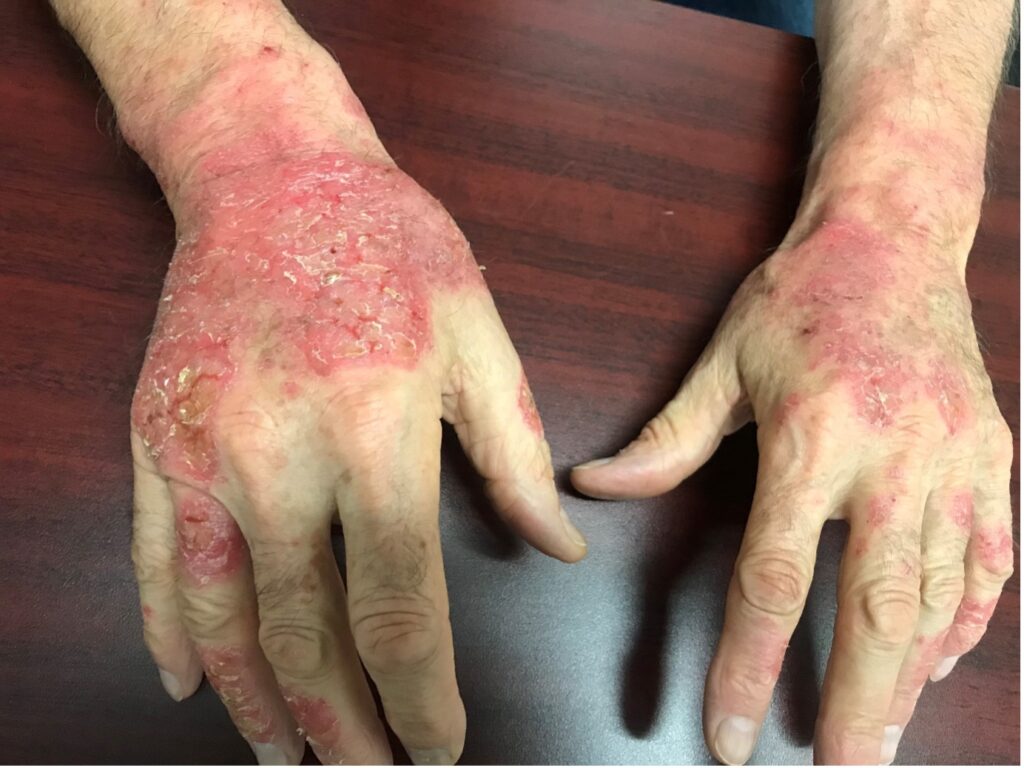Contact dermatitis is a prevalent skin condition that can cause significant discomfort and irritation. It occurs when the skin comes into contact with a substance that either irritates it or triggers an allergic reaction. This article will provide an in-depth look at the types of contact dermatitis, its causes, symptoms, treatment options, and prevention strategies.

What is Contact Dermatitis?
Contact dermatitis is an inflammation of the skin resulting from exposure to allergens or irritants. The condition manifests as a rash, itching, and in some cases, blisters. There are two main types of contact dermatitis: allergic contact dermatitis (ACD) and irritant contact dermatitis (ICD). Understanding these forms can help determine the appropriate treatment and management strategies.
Types of Contact Dermatitis
1. Allergic Contact Dermatitis (ACD)
Allergic contact dermatitis occurs when the immune system reacts to a substance it perceives as harmful, triggering an allergic reaction. Common allergens include nickel, poison ivy, fragrances, and certain chemicals. In ACD, the immune response causes inflammation, redness, swelling, and the formation of blisters.
2. Irritant Contact Dermatitis (ICD)
Irritant contact dermatitis is caused by exposure to substances that directly damage the skin’s outer layer. These irritants may include harsh chemicals, soaps, detergents, or frequent exposure to water. Unlike ACD, ICD does not involve an immune response but rather a physical disruption of the skin barrier. Symptoms typically include dryness, redness, and peeling.
Common Causes and Triggers
Understanding the common causes of contact dermatitis is crucial in managing and avoiding flare-ups. These triggers can vary widely depending on whether the condition is allergic or irritant in nature. Here are some of the most common triggers:
- Allergens:
- Nickel (found in jewelry, watches, and clothing fasteners)
- Poison ivy, poison oak, and poison sumac
- Fragrances in lotions, perfumes, and soaps
- Latex products
- Certain plants, including chrysanthemum and ragweed
- Irritants:
- Harsh cleaning agents (bleach, disinfectants)
- Detergents and soaps with strong chemicals
- Solvents and paints
- Water exposure (frequent hand washing or swimming in chlorinated pools)
- Abrasive materials like sandpaper
Symptoms
The symptoms of contact dermatitis can vary depending on the type and severity of the condition. Common signs to watch for include:
- Redness and inflamed skin
- Itching or burning sensations
- Blisters or small bumps that may ooze fluid
- Dryness or peeling of the skin
- Swelling in the affected area
- Crusting or scabbing of the skin
Symptoms may appear within hours or days after contact with the offending substance. In some cases, repeated exposure may worsen the severity of the condition.
How is Contact Dermatitis Diagnosed?
A healthcare provider typically diagnoses contact dermatitis based on a detailed medical history and physical examination. If the cause is unclear, additional tests, such as a patch test, may be conducted. A patch test involves applying small amounts of potential allergens to the skin to observe any reactions.
Treatment and Management of Contact Dermatitis
Effective treatment for contact dermatitis involves a combination of avoiding triggers, topical treatments, and, in some cases, oral medications. The goal is to reduce inflammation, alleviate symptoms, and prevent recurrence.
1. Topical Corticosteroids
Corticosteroid creams or ointments are commonly prescribed to reduce inflammation and alleviate symptoms of contact dermatitis. They work by suppressing the immune response and calming the skin. These treatments can be used for both allergic and irritant forms of the condition.
2. Emollients and Moisturizers
Frequent use of emollients (moisturizers) can help maintain the skin’s moisture barrier and prevent further irritation. It is essential to apply moisturizers regularly, especially after bathing, to lock in moisture.
3. Antihistamines
If itching is severe, antihistamines may be recommended to help control allergic reactions and reduce discomfort. These medications can also help prevent nighttime itching and improve sleep.
4. Wet Dressings and Cold Compresses
For severe cases, wet dressings or cold compresses may be used to soothe the skin and reduce swelling. This treatment is often combined with topical corticosteroids for faster relief.
5. Oral Medications
In cases where topical treatments are not effective, or if the dermatitis is widespread, oral medications such as corticosteroids may be prescribed. These medications help reduce systemic inflammation and control symptoms.
Preventing Contact Dermatitis
Preventing contact dermatitis involves identifying and avoiding known allergens or irritants. Here are some practical tips to reduce the risk of developing or worsening the condition:
- Identify Triggers: If you know what causes your dermatitis, try to avoid direct contact with these substances. For example, wear gloves when handling cleaning products, or choose jewelry made from non-allergenic materials.
- Wear Protective Clothing: When working with irritants, wearing protective clothing, such as long sleeves, gloves, and hats, can minimize skin exposure.
- Use Hypoallergenic Products: Opt for hypoallergenic soaps, lotions, and shampoos that are less likely to trigger a reaction.
- Moisturize Regularly: Keep your skin moisturized to prevent dryness and protect the skin’s natural barrier.
- Patch Test New Products: Before using new skincare or cosmetic products, perform a patch test to check for any allergic reactions.
How to Manage an Outbreak
If you experience an outbreak of contact dermatitis, follow these steps to manage it effectively:
- Identify and Remove the Trigger: Immediately stop using or coming into contact with the substance that caused the reaction.
- Cleanse the Area: Gently wash the affected skin with mild soap and water to remove any irritants.
- Apply Soothing Treatments: Use cool compresses, emollients, and topical corticosteroids to alleviate symptoms.
- Avoid Scratching: Scratching can worsen the condition and lead to infection. Keep nails trimmed and try to resist the urge to scratch.
When to Seek Medical Help
While most cases of contact dermatitis can be managed with home treatment, it is important to seek medical advice in the following situations:
- If the rash is widespread or covers large areas of the body
- If there is severe swelling, pain, or blistering
- If the symptoms do not improve with home treatments
- If you suspect an infection (red streaks, pus, or fever)
- If the rash affects sensitive areas such as the eyes or genitals

